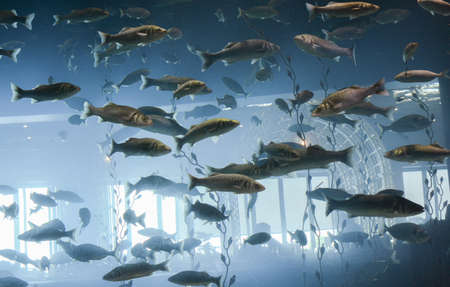Understanding Natural Light Cycles and Their Importance
If you’ve ever spent a peaceful morning watching the golden sunlight stream through your window, you know just how much the rhythm of day and night sets the pace for all life—your aquarium pets included. Mimicking natural light cycles, like gentle sunrises, tranquil sunsets, and even those subtle seasonal shifts, is more than just a treat for your eyes; it’s essential for the health and happiness of your underwater companions. In the wild, fish and aquatic plants are guided by the sun’s daily journey across the sky. These changing patterns tell them when to eat, rest, breed, or even show their brightest colors. By recreating these cues in your home aquarium, you’re offering a slice of their natural world right in your living room. Not only does this reduce stress and encourage natural behaviors, but it can also boost immunity and overall well-being—keeping tails wagging (or fins fluttering!) and scales shimmering. Whether you care for playful guppies or majestic goldfish, understanding and simulating these light cycles is a heartfelt way to ensure your aquatic pets thrive as part of your cozy indoor oasis.
Choosing the Right Aquarium Lighting Setup
If you want to create a slice of nature in your living room, choosing the right aquarium lighting is essential for simulating natural light cycles. For American aquarists, there’s a fantastic range of reliable brands and cutting-edge technology available. Whether you’re keeping a peaceful planted tank or a lively fish community, picking the right light makes all the difference for both aesthetics and animal health.
American Brands to Trust
Many trusted U.S. brands offer aquarium lights specifically designed to mimic natural sunrise, daylight, sunset, and even moonlight. Here’s a handy table to compare some popular options:
| Brand | Type | Main Features | Best For |
|---|---|---|---|
| Current USA | LED (Programmable) | Customizable sunrise/sunset, weather effects, easy app control | Community tanks, planted tanks |
| Fluval | LED (Programmable) | Bluetooth control, color spectrum adjustment, energy-efficient | Planted tanks, aquascaping |
| Aqueon | LED (Fixed & Programmable) | User-friendly timers, affordable options, good for beginners | Freshwater setups, beginners |
| Kessil | LED (Advanced Programmable) | Tunable spectrum and intensity, shimmer effect, WiFi compatible | Reef tanks, advanced hobbyists |
| NICREW | LED (Budget-Friendly) | Dimmable settings, timer functions, simple install | Entry-level tanks, small aquariums |
Main Types of Lights for Natural Simulation
- Standard LED Fixtures: Offer reliable white light with some limited color customization. Great for basic setups and low-light plants.
- Programmable LEDs: Allow you to set daily light schedules—think sunrise at 7am and sunset at 7pm—with gentle transitions that mimic the real outdoors.
- T5/T8 Fluorescents: While classic and affordable, they lack the full spectrum control and energy savings of modern LEDs.
- Hybrid Systems: Combine LEDs with other light sources or add-on modules for specialized needs like reef tanks or high-tech planted aquariums.
What to Look For When Shopping Locally
If you’re browsing your local pet store or favorite online retailer like Chewy or Petco, look for these features:
- Dimmability: Lets you adjust brightness for dawn/dusk simulation.
- Spectrum Options: Full-spectrum or customizable color ranges are best for plant growth and fish coloration.
- Timer/Controller Compatibility: Built-in timers or app-controlled systems make it easy to automate your tank’s light cycle—even if you’re busy running errands or out enjoying the sunshine with your pups.
- Size & Mounting Flexibility: Make sure your fixture fits securely on your tank and matches its dimensions for even coverage.
A Little Extra Tip from My Own Cozy Home Aquarium:
I’ve found that setting my programmable lights to ramp up slowly in the morning—just as the birds start singing outside—keeps both my goldfish and aquatic plants looking their best. Plus, it makes those early coffee moments by the tank feel extra magical!
![]()
3. Programming Light Schedules: Tips & Best Practices
Setting up a daily light routine for your aquarium is essential for creating a harmonious environment that both mimics nature and fits seamlessly into your American household lifestyle. Start by choosing a programmable LED aquarium light—many modern options come with easy-to-use smartphone apps or digital timers. Aim to replicate the natural sunrise and sunset cycle, gradually ramping up the lights in the morning and dimming them at night. This helps reduce stress for your aquatic pets and encourages natural behaviors.
How to Set Up Daily Light Routines
Begin with a 10-12 hour light period, adjusting based on the specific needs of your fish and plants. Most North American species thrive with lights on from around 8 AM to 6 PM, but you can tweak this to suit your schedule. If you’re an early riser or work late shifts, program the light cycle to match when you’re most likely to enjoy viewing your tank—just be consistent, as sudden changes can confuse your aquatic friends.
Adjusting for Daylight Saving Time
Don’t forget about daylight saving time! Twice a year, clocks shift forward or back in many parts of the U.S., which can throw off both you and your aquarium’s rhythm. When this happens, remember to manually adjust your lighting timer so it stays in sync with the household. Many smart timers let you update settings from your phone, making this transition super simple.
Syncing With Your Household Routine
The beauty of programmable lights is their flexibility. Try syncing your aquarium’s lighting schedule with moments when your home is bustling—perhaps a gentle sunrise effect as everyone wakes up, or a soft sunset as family members wind down in the evening. This not only supports healthy habits for your fish but also lets your aquarium become part of your daily ritual, much like feeding your dogs or letting the cats bask in a sunny window. By keeping routines steady and attuned to both pet and human needs, youll create a naturally balanced environment that makes every member of your home feel right at ease.
4. Creating Realistic Day and Night Transitions
One of the most magical ways to mimic nature in your aquarium is by creating gentle transitions between sunrise, daytime, sunset, and moonlight. Not only does this make your tank look stunning, but it also helps reduce stress for your aquatic pets and encourages natural behaviors. Here’s a step-by-step guide to help you set up these realistic light cycles:
Step 1: Gradual Sunrise
Begin each day with a slow increase in light intensity to simulate sunrise. This helps wake your fish gently, mimicking how daylight naturally grows brighter.
| Timeframe | Light Intensity | Notes |
|---|---|---|
| 0-30 min | 10%-40% | Soft white or warm hues work best. |
| 30-60 min | 40%-100% | Transition to full daylight spectrum. |
Step 2: Daytime Brilliance
Maintain bright, steady lighting during the day to encourage healthy plant growth and active behavior in your pets. Make sure the spectrum matches their habitat—most species thrive under full-spectrum (6,500K–8,000K) lights.
Step 3: Gentle Sunset
As evening approaches, gradually dim the lights to simulate sunset. This prepares your pets for rest and signals that nighttime is coming.
| Timeframe | Light Intensity | Notes |
|---|---|---|
| -60 to -30 min before “lights out” | 100%-40% | Add warmer tones for a cozy effect. |
| -30 to 0 min before “lights out” | 40%-10% | Smooth transition helps lower stress levels. |
Step 4: Peaceful Moonlight
A soft blue or dim white light at night mimics the moon and allows nocturnal species to thrive without disturbing sleepers. Aim for less than 10% intensity or use dedicated moonlight LEDs.
A Sample Daily Lighting Schedule:
| Period | Lighting Color/Type | Intensity (%) | Duration (approx.) |
|---|---|---|---|
| Sunrise | Warm white/yellow | 10-100% | 1 hour |
| Daytime | Full-spectrum white | 100% | 8-10 hours |
| Sunset | Warm orange/red tones | 100-10% | 1 hour |
| Moonlight/Nighttime | Pale blue/white LED | <10% | Varies (overnight) |
A Few Tips from a Pet-Loving Aquarist:
- If you have shy or nocturnal critters—like certain catfish or shrimp—they’ll appreciate consistent moonlight for late-night exploring.
- If possible, use an automatic timer or programmable LED system so you don’t have to remember every transition yourself.
- Avoid sudden changes; quick on/off switches can startle both fish and snails!
Your aquatic buddies will thank you with brighter colors and more playful antics when you respect their natural rhythms—it’s just like letting your dogs or cats nap in a sunny window at home!
5. Adapting Light Cycles for Different Species
Special Considerations for Common Aquarium Inhabitants
When simulating natural light cycles in your aquarium, it’s essential to consider the unique needs of your tank’s residents. Not all species thrive under the same conditions, and tailoring your lighting schedule can make a big difference in the health and happiness of your aquatic community.
Fish: Balancing Activity and Rest
Popular fish species in U.S. home aquariums like tetras, guppies, bettas, and cichlids often originate from environments with distinct day and night periods. Aim for 10-12 hours of light daily to mimic a tropical day. Avoid leaving lights on 24/7—fish need downtime to reduce stress and maintain healthy sleep cycles. Use timers to ensure consistency, and try a gradual ramp-up and dim-down to simulate dawn and dusk, which helps ease transitions and reduces startling.
Shrimp: Protecting Sensitive Invertebrates
Amano, cherry, and ghost shrimp are increasingly popular in American tanks. These little guys can be sensitive to sudden or intense light changes. Provide gentle morning and evening transitions with adjustable LED systems, and include shaded areas with plants or decor. Shrimp benefit from a slightly shorter photoperiod—around 8-10 hours—especially if algae growth is a concern.
Aquatic Plants: Supporting Growth Without Overexposure
If you keep live plants such as Anubias, Java fern, Amazon sword, or crypts, they’ll need sufficient light for photosynthesis but not so much that algae takes over. Most common aquarium plants do well with 8-10 hours of medium-intensity light per day. Adjust depending on plant type—high-light species may want closer to 12 hours, while low-light varieties thrive on less. Remember that too much light can lead to nuisance algae, so monitor your tank’s balance carefully.
Sensitive Species: Catering to Special Needs
Certain species like discus fish or wild-caught catfish require extra attention when it comes to lighting. These creatures often prefer dimmer environments or lots of hiding places. Use floating plants or decor to diffuse light and create shaded retreats. Always research the specific requirements of any sensitive species you introduce to your aquarium, as some may even require periods of total darkness to mimic their native habitats.
Local Tip: Mimic Your Region’s Seasons
If you want to go the extra mile for authenticity (and maybe impress your fellow hobbyists at the next local fish club meeting), try adjusting your lighting schedule slightly throughout the year to reflect seasonal changes like those in the U.S.—a bit more daylight in summer, a touch less in winter. Your aquatic pets might not notice every detail, but it helps create a more natural rhythm in your cozy indoor pond.
6. Troubleshooting Common Light Cycle Issues
Dealing with Algae Blooms
One of the most frequent concerns for American aquarists is an unexpected algae outbreak. If your tank starts looking like a green soup or your decorations get slimy, excessive light exposure might be to blame. To combat this, first ensure your lighting schedule mimics natural daylight—typically no more than 8-10 hours per day. Consider using a timer for precision. Additionally, check if your aquarium is receiving extra sunlight from nearby windows, as even indirect sunlight can fuel algae growth. Cutting back on feeding and performing regular water changes will also help keep those pesky blooms at bay.
Addressing Pet Disruptions
Sometimes our furry (or scaly!) friends can interfere with carefully set light cycles. Cats may paw at cords or timers, while curious dogs could accidentally unplug devices during their indoor adventures. To prevent such mishaps, secure all cords out of reach and invest in durable, pet-proof timer outlets. For fish that seem stressed by sudden light changes—perhaps darting around when lights snap on—try using dimmable LEDs or fixtures with gradual sunrise/sunset settings to ease transitions and mimic dawn and dusk more naturally.
Solving Timer Malfunctions
In many American households, power outages or faulty timers can throw off even the best-laid lighting plans. If you notice erratic lighting patterns or missed cycles, double-check your timer’s programming and replace batteries if it’s battery-powered. Digital timers tend to be more reliable than mechanical ones, offering greater precision and backup memory during short outages. For extra peace of mind, consider smart plugs that allow you to monitor and adjust your aquarium’s lighting schedule directly from your smartphone—even if you’re away for the weekend enjoying some countryside relaxation with your pets!
When in Doubt: Routine Checks
Staying proactive is key for maintaining healthy light cycles in your aquarium oasis. Make it a habit to inspect timers, lights, and cords weekly—especially if you share your home with inquisitive pets or energetic kids. A few moments of routine maintenance can save you from algae headaches and keep your aquatic friends thriving under perfectly timed rays.
Your Calm, Country-Style Aquarium Awaits
By troubleshooting these common issues with a gentle touch and a little country know-how, you’ll create a stable environment where both plants and fish can flourish—just like a sunny spot on the porch surrounded by beloved pets and peaceful rural views.


